Have you ever heard of Ophiuchus? This mysterious figure from Greek mythology remains shrouded in enigma, often overlooked and forgotten. But who exactly is Ophiuchus? Is it a god, a hero, or perhaps a constellation? In this fascinating article, we will delve into the depths of ancient Greek beliefs and legends to unravel the truth behind Ophiuchus as the Serpent-Bearer. From its origins in Greek mythology to its symbolism in astrology and its representation in art and popular culture, we will piece together the pieces of the puzzle to shed light on this elusive and intriguing figure. Prepare to venture into the realm of mythology as the secrets of Ophiuchus are unveiled before our eyes.
Contents
- The Origins of Ophiuchus
- The Legend of Ophiuchus
- The Symbolism of Ophiuchus
- The Forgotten Zodiac Sign
- Relevant Artifacts and Representations
- Ophiuchus in Popular Culture
- Ophiuchus: A Modern Interpretation
- The Ophiuchus Enigma: Unraveling the Truth
- Conclusion
-
Frequently Asked Questions
- What does Ophiuchus represent in Greek mythology?
- Is Ophiuchus considered a god in Greek mythology?
- What is the story behind Ophiuchus and the serpent?
- How is Ophiuchus depicted in ancient Greek art?
- What is the significance of Ophiuchus in astrology?
- Are there any artifacts that depict Ophiuchus from ancient Greece?
- Has Ophiuchus been referenced in literature?
- How has Ophiuchus been portrayed in movies and television?
- Are there any recent astronomical discoveries related to Ophiuchus?
- Is there an alternative astrology system that includes Ophiuchus?
- References
-
Frequently Asked Questions
- 1. Can you explain the significance of Ophiuchus in Greek mythology?
- 2. How was Ophiuchus conceived in Greek mythology?
- 3. What is the legend behind Ophiuchus and the Serpent?
- 4. How does Ophiuchus relate to the concept of healing?
- 5. What does the Serpent-Bearer constellation represent?
- 6. How is Ophiuchus interpreted in astrology?
- 7. Are there any ancient Greek artifacts depicting Ophiuchus?
- 8. How is Ophiuchus represented in contemporary art?
- 9. Has Ophiuchus made appearances in literature?
- 10. How has Ophiuchus been portrayed in movies and television?
- References
- Read More
The Origins of Ophiuchus
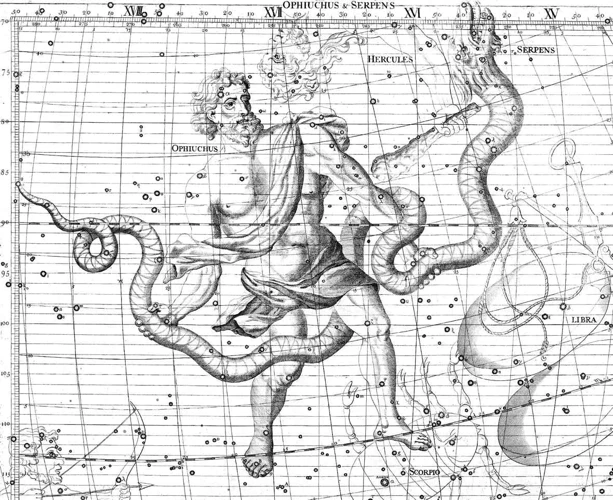
The origins of Ophiuchus are as elusive as the figure itself. In Greek mythology, Ophiuchus is believed to have been created during the Titanomachy, the epic battle between the Titans and the Olympian gods. Some myths suggest that Ophiuchus was the son of Apollo, the god of healing and prophecy, while others claim that Ophiuchus was a mortal who possessed exceptional healing abilities. Interestingly, Ophiuchus is also associated with the serpent, highlighting its connection to ancient serpent symbolism found in various mythologies around the world. To unravel the true origins of Ophiuchus, we must explore its role in ancient Greek beliefs and the significance of serpent symbolism in mythology. This will bring us one step closer to understanding the enigma that is Ophiuchus.
1.1 The Creation of Ophiuchus
The creation of Ophiuchus is a fascinating aspect of its mythology. According to some accounts, Ophiuchus is said to be the son of Apollo, the Greek god of healing and medicine. In this narrative, Ophiuchus inherited his father’s remarkable healing abilities and became a renowned healer himself. His knowledge of medicinal plants and techniques was said to be unparalleled. Other myths suggest that Ophiuchus was a mortal who caught the attention of the gods due to his extraordinary healing skills. As a reward for his exceptional talent, Ophiuchus was granted a place among the constellations, immortalized as the Serpent-Bearer. This celestial status not only elevated Ophiuchus to the realm of the gods but also solidified his connection to the serpent, symbolizing his healing powers and wisdom. The creation of Ophiuchus thus intertwines the realms of divine intervention and mortal prowess, emphasizing the significance of healing in ancient Greek mythology. To explore further connections between animal symbolism and mythology, you can check out our article on Egyptian mythology and sacred animal symbolism.
1.2 Ophiuchus in Ancient Greek Beliefs
In ancient Greek beliefs, Ophiuchus held a significant role that intertwined with various aspects of their mythology. Ophiuchus was often associated with the healing arts and was revered as a great healer. Greek legends tell tales of Ophiuchus’s exceptional knowledge of herbs, medicines, and the ability to cure even the most complex ailments. This association with healing further strengthens the connection between Ophiuchus and the serpent, as serpents were believed to possess regenerative and transformative powers. Ophiuchus’s healing abilities were said to surpass those of any mortal, and there are stories of him resurrecting the dead, a feat only reserved for the gods. Due to his extraordinary healing capabilities, Ophiuchus was sometimes seen as a divine figure and worshipped in certain regions. While Ophiuchus’s role as a healer remained prominent, he also became associated with the study of astronomy and the interpretation of celestial signs. It was believed that Ophiuchus possessed deep wisdom and insight regarding the stars, and his observations guided the Greeks in understanding the cosmos. This connection between Ophiuchus and the sky further solidified his position as a unique and revered figure in ancient Greek beliefs.
The Legend of Ophiuchus

The legend of Ophiuchus is a captivating tale woven into the tapestry of Greek mythology. At the heart of this legend is the story of Asclepius, a legendary healer who possessed great knowledge of medicinal arts and the ability to raise the dead. Asclepius, often depicted holding a staff entwined with a serpent, became synonymous with healing and rejuvenation. According to mythology, Zeus, fearful of Asclepius’ powers, struck him down with a thunderbolt, sending him into the heavens as the constellation Ophiuchus. In this celestial form, Ophiuchus forever carries the serpent, symbolizing the power of healing. The legend of Ophiuchus not only highlights the significance of healing in ancient Greek society but also explores the eternal struggle between mortality and immortality. To delve deeper into the connection between Ophiuchus and healing, as well as its associations with astrology, art, and popular culture, continue reading the sections below.
2.1 Ophiuchus and the Serpent
Ophiuchus, the enigmatic figure of Greek mythology, is intimately connected to the serpent. The serpent holds great significance in mythology and symbolism, representing both divine and primal forces. In the case of Ophiuchus, the serpent plays a crucial role in shaping its legend. According to one myth, Ophiuchus came into possession of a sacred serpent that possessed incredible healing powers. It is said that Ophiuchus learned the secrets of healing by observing how the serpent shed its skin and renewed itself. The serpent became a symbol of rejuvenation and transformation, reflecting the power of Ophiuchus to heal and restore. This association with serpents is not limited to Ophiuchus alone. Serpent symbolism permeates various mythologies, such as the Egyptian god Wadjet, the symbol of Lower Egypt, and the Greek god Hermes, who used the Caduceus, a staff entwined with two serpents, as his symbol. Serpents are often depicted as creatures of wisdom, knowledge, and rebirth, bringing a deeper understanding to the connection between Ophiuchus and the serpent. To explore further into the realm of serpent symbolism in mythology, you can delve into the fascinating topic of sacred animal symbolism in Egyptian mythology. By understanding the intricate relationship between Ophiuchus and the serpent, we can gain insights into the role played by this mythical figure in ancient Greek beliefs and traditions.
2.2 Ophiuchus and Healing
In Greek mythology, Ophiuchus is prominently associated with the art of healing. This connection stems from the figure’s depiction as a master healer and physician. Ophiuchus is often portrayed holding a staff with a snake wrapped around it, known as the Rod of Asclepius. This symbol, which is still used today in the medical field, represents healing and rejuvenation. Ophiuchus’s healing abilities are said to have surpassed those of any mortal or god, making him a figure of great admiration and reverence. According to ancient beliefs, Ophiuchus possessed deep knowledge of herbal medicine, surgery, and the manipulation of energies to cure ailments. He was believed to have the power to heal both physical and spiritual illnesses, bringing harmony and balance to those in need. With such extraordinary healing capabilities, Ophiuchus symbolizes the eternal quest for knowledge and the innate human desire to alleviate suffering. Through his mythology, Ophiuchus emphasizes the importance of healing and the pursuit of well-being in both ancient and modern times. To learn more about unconventional traits and their astrological significance, check out our article on unveiling unconventional traits of Aquarius.
The Symbolism of Ophiuchus
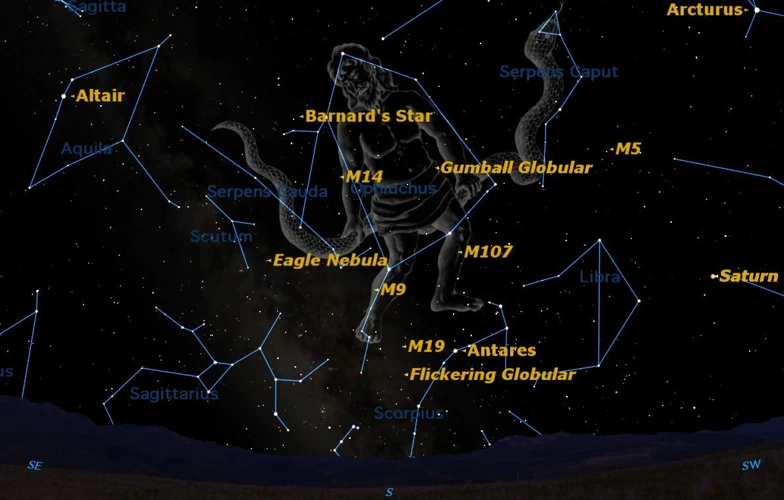
The symbolism of Ophiuchus is multifaceted and deeply rooted in ancient beliefs. One of the prominent symbols associated with Ophiuchus is the Serpent-Bearer constellation, which is represented by a man holding a serpent. This constellation holds great significance in astrology, as it is seen as a bridge between the constellations of Scorpio and Sagittarius. The serpent itself carries various symbolic meanings, including wisdom, healing, and transformation. In astrology, Ophiuchus is often considered the 13th zodiac sign, existing alongside the traditional 12 signs. This alternative interpretation adds an air of mystery and intrigue to Ophiuchus, challenging the traditional astrological system. To delve deeper into the symbolism of Ophiuchus and its connection to other zodiac signs, such as Gemini and Libra, click here for an insightful exploration of the intricate interplay between these signs.
3.1 The Serpent-Bearer Constellation
The Serpent-Bearer Constellation, also known as Ophiuchus, is a fascinating celestial phenomenon that holds a prominent place in ancient mythology and astrology. It is located near the celestial equator, between the constellations of Scorpio and Sagittarius. Ophiuchus is represented as a figure holding a serpent, symbolizing the power of healing and wisdom. The constellation itself is quite large and spans across multiple degrees of the night sky. It consists of several notable stars, including Rasalhague, the brightest star in the constellation, which means “Head of the Snake” in Arabic. Another important star is Barnard’s Star, one of the closest known stars to our solar system.
What makes the Serpent-Bearer Constellation intriguing is its association with the Greek myth of Asclepius, the god of medicine and healing. Asclepius was said to have been skilled in the art of healing and was often depicted holding a staff around which a serpent was entwined. This depiction is believed to be the inspiration behind the constellation’s representation. The Serpent-Bearer Constellation serves as a celestial homage to the healing powers attributed to Asclepius, symbolizing the importance of wisdom and knowledge in the field of medicine.
In astrology, the presence of Ophiuchus as a thirteenth zodiac sign has been a subject of debate. While traditional astrology recognizes twelve zodiac signs, some astrologers include Ophiuchus as an additional sign. Those born under Ophiuchus are said to possess traits of healing, transformation, and insight. However, it’s essential to note that this approach is not widely accepted or incorporated into mainstream astrology.
The Serpent-Bearer Constellation, with its rich mythology and astrological significance, continues to captivate stargazers and enthusiasts alike. Its celestial presence serves as a reminder of the ancient connection between the heavens and human beliefs, inviting us to explore the mysteries of the universe and our own existence.
3.2 Ophiuchus in Astrology
In the realm of astrology, the inclusion of Ophiuchus has long been a subject of debate and fascination. Traditionally, the zodiac system consists of twelve signs, each representing different personality traits and characteristics. However, the discovery of Ophiuchus as a thirteenth sign has disrupted this established system. Ophiuchus is said to encompass those born between November 30th and December 17th, overlapping with the dates of the Sagittarius and Scorpio signs. Astrologers who recognize Ophiuchus as a valid sign believe that individuals born under this sign possess unique qualities and traits. They are often described as being intuitive, passionate, and driven to seek knowledge and spiritual growth. Ophiuchus is also associated with healing and transformation, symbolizing the ability to heal oneself and others on a deep level. However, it is important to note that not all astrologers acknowledge Ophiuchus as an official sign, and its inclusion in the zodiac system remains a topic of controversy. As astrology continues to evolve and adapt, the significance of Ophiuchus in this realm is continuously being explored and reevaluated.
The Forgotten Zodiac Sign
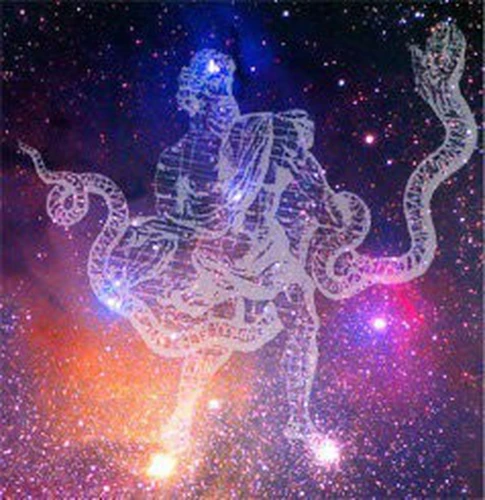
Often overshadowed by the traditional twelve zodiac signs, Ophiuchus remains the forgotten zodiac sign, hidden in plain sight. While the familiar zodiac signs have been widely embraced and studied for centuries, Ophiuchus has been largely overlooked and excluded from mainstream astrology. Its absence in popular horoscopes and astrological charts has led many to question its significance and existence.
The neglect of Ophiuchus is a result of the historical development of the Western zodiac system. The traditional twelve signs were established over two thousand years ago, based on the annual path of the Sun relative to the Earth. However, the path of the Sun also passes through the constellation of Ophiuchus, challenging the exclusivity of the twelve zodiac signs.
Despite this celestial overlap, Ophiuchus was excluded from the zodiac system by the ancient astronomer and mathematician Claudius Ptolemy in the 2nd century AD. Ptolemy’s decision was likely influenced by the desire to maintain a system that aligned with the twelve-month calendar, as well as the simplicity and symmetry of a twelve-sign zodiac.
However, the exclusion of Ophiuchus does not diminish its significance. Those born between November 29 and December 17 would fall under the sign of Ophiuchus, the Serpent-Bearer. Those born under this sign are believed to possess traits of healing, wisdom, and introspection. They are natural seekers of knowledge and have a deep connection to spiritual and metaphysical realms.
While Ophiuchus may have been forgotten in mainstream astrology, there is a growing interest in exploring its influence and incorporating it into astrological practices. Astrologers and enthusiasts are recognizing the need for a more inclusive and dynamic zodiac system that acknowledges the existence of Ophiuchus.
The forgotten zodiac sign of Ophiuchus serves as a reminder that astrology is a continuously evolving field, one that can benefit from embracing diversity and expanding its horizons. So, let us not forget the Serpent-Bearer, for within its enigmatic presence lies a wealth of untapped wisdom and potential.
Relevant Artifacts and Representations
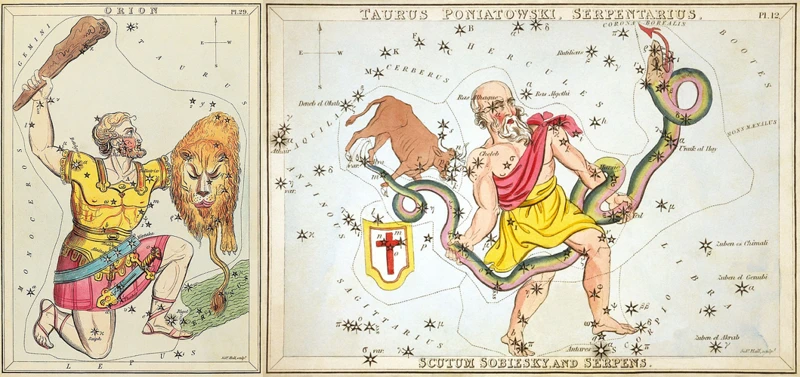
Throughout history, various artifacts and representations have shed light on the presence of Ophiuchus in ancient Greek culture and beyond. In ancient Greek art, Ophiuchus is often depicted as a figure holding a serpent, symbolizing the serpent-bearer constellation. These depictions highlight the association of Ophiuchus with healing and medicine, showcasing the belief in its divine powers. Moving to contemporary times, Ophiuchus continues to inspire artists who bring this mysterious figure to life through their interpretations. Paintings, sculptures, and even tattoos showcase the significance of Ophiuchus in modern artistic expressions. By examining these artifacts and representations, we gain a deeper understanding of the lasting impact of Ophiuchus in both ancient and contemporary art forms.
5.1 Ancient Greek Art
Ancient Greek art holds a treasure trove of representations and depictions of Ophiuchus that provide a glimpse into how the figure was perceived in that era. One notable artwork that showcases Ophiuchus is the large mosaic found in the House of the Physician in Pompeii. This exquisite mosaic portrays Ophiuchus as a central figure, standing tall and holding a staff with a serpent wrapped around it, emphasizing his association with healing and medicine. The serpent’s presence reinforces the connection between Ophiuchus and the serpent symbolism prevalent in ancient Greek culture.
Another fascinating example of Ophiuchus in ancient Greek art is found on ancient coins. One such coin, minted in the Greek city of Abdera, features the image of Ophiuchus holding a serpent, further cementing the serpent-bearer association. The inclusion of Ophiuchus on coins demonstrates his significance and influence in society, as coins often depicted important gods, figures, and symbols.
Various ancient Greek sculptures exhibit Ophiuchus in different forms. Sculptures such as the Hermes and Ophiuchus statue from the 2nd century BCE depict Hermes with a snake-entwined staff, indicating the close association between Hermes and Ophiuchus. Another renowned sculpture, the carved marble relief known as the Ophiuchus relief, portrays Ophiuchus as a bearded figure holding a staff topped with a snake, symbolizing his healing abilities.
The presence of Ophiuchus in ancient Greek art showcases the importance of this figure in their culture. Through these artistic representations, we gain insight into how Ophiuchus was revered as a powerful and esteemed entity, associated with healing, medicine, and the symbology of the serpent. These artistic depictions allow us to appreciate how Ophiuchus was ingrained in the fabric of ancient Greek society, leaving an indelible mark on their art and mythology.
5.2 Contemporary Depictions
In the realm of contemporary depictions, Ophiuchus has found its place in various forms of art and culture. Artists and writers have been intrigued by the mystique surrounding Ophiuchus, and it has become a subject of fascination and inspiration. In art, Ophiuchus is often depicted as a figure holding a serpent, symbolizing its role as the Serpent-Bearer. These depictions can be seen in paintings, sculptures, and even modern digital artwork. Ophiuchus has also made its way into literature, where it is often portrayed as a powerful healer or a guardian figure. In recent years, Ophiuchus has gained attention in popular culture, with its inclusion in movies, television shows, and even video games. These contemporary depictions bring Ophiuchus to life in new and imaginative ways, keeping the ancient myth alive and allowing it to resonate with modern audiences. Whether it’s through visual art or storytelling, Ophiuchus continues to captivate and inspire, solidifying its place in contemporary depictions of mythological figures.
Ophiuchus in Popular Culture
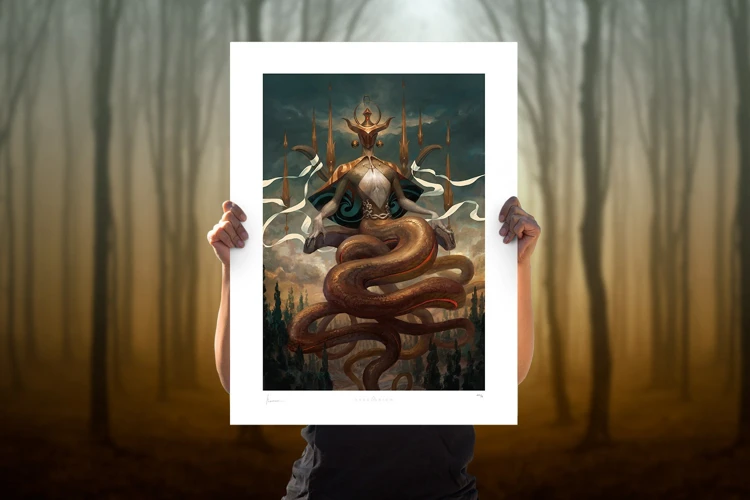
Known for its mystique and intrigue, Ophiuchus has made its mark in popular culture across various mediums. In literature, Ophiuchus has been referenced as a symbol of wisdom, healing, and transformation, often representing characters with extraordinary abilities or knowledge. One notable example is in Rick Riordan’s “Percy Jackson” series, where Ophiuchus plays a significant role in the storyline, connecting ancient Greek mythology to modern times. In the world of movies and television, Ophiuchus has also found its place. It has been depicted in fantasy and science fiction films, with characters embodying the traits associated with the Serpent-Bearer, such as deep knowledge and the power to heal. As a fascinating and often overlooked figure, Ophiuchus continues to capture the imagination of artists and creators, serving as a source of inspiration for stories that delve into the realms of mythology, mysticism, and the human condition.
6.1 Ophiuchus in Literature
In the realm of literature, Ophiuchus makes rare appearances, yet its presence leaves a lasting impression. One notable example is in Dante Alighieri’s epic poem, The Divine Comedy. In the Inferno, Ophiuchus is mentioned as a constellation that can be seen in the southern hemisphere. The inclusion of Ophiuchus in this iconic work showcases its significance in the celestial world. Another literary reference can be found in J.K. Rowling’s beloved Harry Potter series, where Ophiuchus is briefly mentioned as a sign of the zodiac. Although not explored in depth, this subtle inclusion adds a touch of mystique to the wizarding world. Ophiuchus has made its way into various science fiction novels, often depicted as a powerful and enigmatic character with exceptional healing abilities. These literary references, although sparse, highlight the fascination and intrigue surrounding Ophiuchus in the realm of literature.
6.2 Ophiuchus in Movies and Television
While Ophiuchus may be a lesser-known figure in Greek mythology, it has made its way into the realm of movies and television, leaving its mark on popular culture. In recent years, Ophiuchus has been featured in various films and TV shows, captivating audiences with its mysterious and mythological allure. One notable representation of Ophiuchus can be found in the hit TV series “American Gods,” based on Neil Gaiman’s novel of the same name. In the show, Ophiuchus is depicted as a powerful deity who embodies healing and transformation. This portrayal showcases Ophiuchus’s connection to the serpent and its ability to bring about change and renewal. Another example of Ophiuchus’s presence in pop culture can be seen in the film “The Librarian: Curse of the Judas Chalice.” Here, the main character encounters Ophiuchus as a mystical artifact and becomes entangled in a quest to protect it from falling into the wrong hands. These representations of Ophiuchus serve to not only entertain but also pique the curiosity of viewers, sparking an interest in exploring the mythology and symbolism behind this intriguing figure. As Ophiuchus continues to make its way into the world of movies and television, it further solidifies its place in popular culture, ensuring that its legacy endures.
Ophiuchus: A Modern Interpretation

In modern times, Ophiuchus has taken on new meanings and interpretations. The discovery of Ophiuchus as a constellation has sparked scientific curiosity and astronomical research. Astronomers have studied this constellation and its associated celestial objects, expanding our understanding of the universe and our place within it. Additionally, Ophiuchus has become a point of interest for alternative astrology enthusiasts. Some believe that Ophiuchus should be recognized as an additional zodiac sign, challenging the traditional twelve-sign zodiac system. There are ongoing debates about the characteristics and traits associated with those born under Ophiuchus, with some embracing its unique qualities and others dismissing it as an astrological anomaly. This modern interpretation of Ophiuchus raises intriguing questions about the evolving nature of mythology, astrology, and our quest to unravel the mysteries of the cosmos.
7.1 Ophiuchus and Astronomical Discoveries
Ophiuchus and astronomical discoveries have gone hand in hand throughout history, revealing fascinating insights into the vastness of our universe. Over the centuries, astronomers have made numerous groundbreaking discoveries within the Ophiuchus constellation. One of the notable astronomical findings is the discovery of stellar nurseries and stellar clusters. These regions within Ophiuchus contain a multitude of young, bright stars, providing valuable insights into the formation and evolution of stars. Another significant discovery linked to Ophiuchus is the identification of black holes. Scientists have detected supermassive black holes at the centers of galaxies within the constellation, fueling their understanding of these cosmic phenomena.
In recent times, technological advancements, such as space telescopes and radio astronomy, have enabled astronomers to delve even deeper into the mysteries of Ophiuchus. For example, the Chandra X-ray Observatory has captured stunning X-ray images of the Ophiuchus galaxy cluster, revealing the intricate structures and dynamics within this cosmic congregation. These observations have helped astronomers better understand the behavior of dark matter, the distribution of hot gas, and the processes occurring within the cluster.
Astronomers continue to explore Ophiuchus in search of exoplanets within its stellar systems. The detection of planets orbiting stars in this constellation expands our knowledge of planetary systems and the potential for conditions conducive to life beyond our own planet.
The ongoing astronomical discoveries within Ophiuchus demonstrate the ever-expanding frontier of knowledge that exists in the study of our universe. Through these investigations, scientists paint a vivid picture of the complexities and wonders that reside within the Serpent-Bearer constellation.
7.2 Ophiuchus and Alternative Astrology
Ophiuchus, the enigmatic and often overlooked Zodiac sign, has found its place in alternative astrology. While traditional Western astrology recognizes only 12 Zodiac signs, alternative astrologers have embraced Ophiuchus as the 13th sign, opening up new interpretations for individuals born between November 29th and December 17th. Alternative astrology enthusiasts assert that Ophiuchus brings unique traits and characteristics to its natives, challenging the traditional zodiac archetypes. Ophiuchus is believed to possess a deep connection to spirituality and healing, making individuals born under this sign natural healers and seekers of higher truths. These alternative astrologers argue that Ophiuchus represents the balance between the physical and spiritual realms, encouraging those under its influence to seek personal transformation and self-discovery. While mainstream astrology may not fully recognize Ophiuchus as a Zodiac sign, the alternative astrology community continues to explore and unravel the mysteries surrounding this celestial figure, offering individuals a fresh perspective and a chance to connect with a different cosmic energy. Whether you choose to embrace Ophiuchus as a part of your astrological identity or not, its inclusion in alternative astrology serves as a reminder of the ever-evolving nature of our understanding of the stars and their influence on our lives.
The Ophiuchus Enigma: Unraveling the Truth

The Ophiuchus Enigma: Unraveling the Truth takes us on a journey to decode the mysteries and misconceptions surrounding this enigmatic figure. Many people are unaware that Ophiuchus is not commonly recognized as one of the twelve zodiac signs, despite its prominence in Greek mythology. The truth is that the inclusion of Ophiuchus in the zodiac system is a matter of debate and interpretation. Some astrologers argue that Ophiuchus should indeed be considered as the thirteenth zodiac sign, disrupting the traditional order and adding a new dimension to the astrological chart. However, mainstream astrology continues to adhere to the twelve zodiac signs we are familiar with. The question remains: why is Ophiuchus often overlooked or omitted from the zodiac? One explanation could be the symmetry and divisibility of the twelve signs, making it more convenient for astrological calculations. Another possibility is that Ophiuchus does not fit neatly into the traditional archetypes and characteristics associated with the zodiac signs. Additionally, not all cultures and astrological systems recognize Ophiuchus, further contributing to the confusion surrounding its status. Despite the ongoing debates, many individuals find personal resonance and identification with Ophiuchus, embracing its unique qualities and seeking to explore its influence on their lives. As we continue to unravel the truth behind the Ophiuchus enigma, we are reminded of the ever-evolving nature of astrology and the enduring fascination with the mysteries of the cosmos. Whether Ophiuchus is recognized as a zodiac sign or not, its symbolism and mythology captivate our imagination, reminding us of the deep connections between ancient beliefs and our modern understanding of the universe.
Conclusion

In conclusion, the story of Ophiuchus as the Serpent-Bearer in Greek mythology is a captivating tale that intertwines ancient beliefs, celestial symbolism, and human curiosity. While Ophiuchus has often been overlooked in favor of the traditional twelve zodiac signs, its significance cannot be ignored. Through our exploration of Ophiuchus’ origins, legends, symbolism, and representations, we have gained a deeper understanding of this enigmatic figure. Ophiuchus challenges our understanding of the cosmos and invites us to question the boundaries of astrological interpretation. The rediscovery and reimagining of Ophiuchus in popular culture and alternative astrology demonstrate its enduring intrigue. Whether we view Ophiuchus as a constellation, a god, or a symbol of healing, its presence reminds us of the rich layers of mythology that continue to resonate with us today. As we continue to uncover the mysteries of the universe, Ophiuchus will remain a fascinating piece of the celestial puzzle, encouraging us to keep seeking knowledge and embracing the complexities of the world around us.
Frequently Asked Questions

What does Ophiuchus represent in Greek mythology?
In Greek mythology, Ophiuchus represents a mythical figure who is often associated with healing and medicine. He is believed to possess great knowledge and skill in the art of healing.
Is Ophiuchus considered a god in Greek mythology?
Although Ophiuchus is often attributed with god-like abilities, he is not considered one of the twelve major gods of Greek mythology. Rather, he is a lesser-known figure who plays a significant role in the realm of healing.
What is the story behind Ophiuchus and the serpent?
According to one myth, Ophiuchus came across a serpent while walking through a field. He killed the serpent, but another snake appeared and placed a healing herb in its mouth. Ophiuchus then realized the healing powers of the serpent and gained the ability to bring the dead back to life.
How is Ophiuchus depicted in ancient Greek art?
In ancient Greek art, Ophiuchus is often shown as a bearded man holding a staff with a serpent wrapped around it. This depiction symbolizes his association with healing and medicine.
What is the significance of Ophiuchus in astrology?
Ophiuchus is often referred to as the thirteenth zodiac sign, although it is not officially recognized in traditional Western astrology. Some believe that Ophiuchus represents a transformative and healing energy that can bring about personal growth and spiritual evolution.
Are there any artifacts that depict Ophiuchus from ancient Greece?
While there are no specific artifacts that solely depict Ophiuchus, there are ancient Greek artworks that feature him among other mythological figures. These artworks provide valuable insights into how the ancient Greeks perceived Ophiuchus.
Has Ophiuchus been referenced in literature?
Yes, Ophiuchus has been referenced in various works of literature. In some instances, Ophiuchus appears as a sage or a wise healer who plays a pivotal role in the narrative.
How has Ophiuchus been portrayed in movies and television?
Ophiuchus is not as commonly depicted in movies and television as other mythological figures. However, in some fantasy or mythological-themed shows, Ophiuchus may make brief appearances or be referenced indirectly.
While there have been ongoing astronomical discoveries, there are no recent findings specifically related to Ophiuchus. However, advancements in technology continue to enhance our understanding of the stars and constellations, including Ophiuchus.
Is there an alternative astrology system that includes Ophiuchus?
Yes, some alternative astrology systems include Ophiuchus as a zodiac sign. These systems propose different dates and characteristics for individuals born under Ophiuchus, offering an alternative perspective on astrology.
References
Frequently Asked Questions

1. Can you explain the significance of Ophiuchus in Greek mythology?
Ophiuchus played a crucial role in ancient Greek beliefs as the Serpent-Bearer. This constellation represented the figure of a healer and symbolized the power of transformation and rebirth.
2. How was Ophiuchus conceived in Greek mythology?
Ophiuchus was created from the Greek myths surrounding Asclepius, a skilled physician. Asclepius’s ability to heal was so remarkable that it caught the attention of the gods, leading to his transformation into the constellation Ophiuchus.
3. What is the legend behind Ophiuchus and the Serpent?
The legend tells the story of Asclepius using his healing powers to resurrect the dead. This act angered Hades, the god of the underworld, who expressed his displeasure by sending a venomous serpent to kill Asclepius. However, instead of being harmed, Asclepius managed to tame the serpent and use its venom for medicinal purposes.
4. How does Ophiuchus relate to the concept of healing?
Ophiuchus is strongly associated with healing and medicine in Greek mythology due to Asclepius’s role as a renowned physician. The constellation’s presence signifies the transformative power of medicine and the ability to restore health.
5. What does the Serpent-Bearer constellation represent?
The Serpent-Bearer constellation represents the figure of Ophiuchus, the healer. The image of Ophiuchus holding a serpent embodies the concept of transformation, suggesting that healing requires embracing change and undergoing a process of inner healing.
6. How is Ophiuchus interpreted in astrology?
In astrology, Ophiuchus is often considered as the thirteenth zodiac sign, positioned between Scorpio and Sagittarius. Those born under the Ophiuchus sign are believed to possess qualities such as wisdom, intuition, and healing abilities.
7. Are there any ancient Greek artifacts depicting Ophiuchus?
Yes, there are several ancient Greek artifacts that feature depictions of Ophiuchus. These artifacts include pottery, coins, and sculptures illustrating Ophiuchus in his role as the Serpent-Bearer and symbol of healing.
8. How is Ophiuchus represented in contemporary art?
Contemporary artists often depict Ophiuchus in various forms, ranging from paintings and illustrations to sculptures and digital art. These representations often emphasize the constellation’s connection to healing and transformation.
9. Has Ophiuchus made appearances in literature?
Absolutely! Ophiuchus has been featured in numerous works of literature, showcasing its mythical and symbolic aspects. From ancient Greek texts to modern novels, Ophiuchus’s presence adds depth to storytelling, often exploring themes of healing and personal growth.
10. How has Ophiuchus been portrayed in movies and television?
Ophiuchus has made appearances in various movies and television shows, often portrayed as a character with healing abilities or as a symbol of transformation. These portrayals tap into the fascination with the mythical qualities of Ophiuchus, captivating audiences with its rich symbolism.
References
- What Do You Think About Ophiuchus, The 13th Sign Of …
- Ophiuchus | Astrology, Zodiac, Mythology
- Ophiuchus Constellation (the Serpent Bearer)







